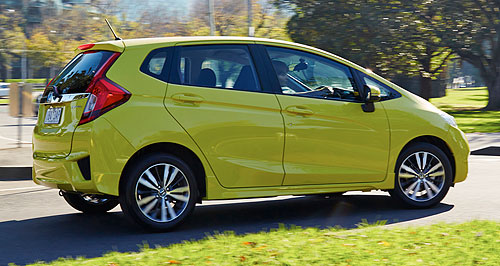News - General NewsInsurer warns on bumper riskCrunched: Insurer IAG says vehicles such as the Honda Jazz can suffer terminal damage due to the lack of a steel inner bumper. Lack of inner steel rear bumper ‘can write-off a car in a 10km/h nose-tail impact’15 Apr 2015 By IAN PORTER A MAJOR vehicle insurer is planning to name and shame car-makers that sell cars in Australia with no steel rear bumper behind the plastic rear panel. Fleet managers have been warned to make sure the cars they buy have a steel rear bumper to keep down claims – and premiums. The lack of a steel rear inner bumper can lead to a vehicle being written off in what otherwise would be a minor bungle at around 10km/h, warned IAG Group head of research Robert McDonald. Speaking at the annual conference of the Australasian Fleet Managers Association (AFMA), Mr McDonald said some of the most vulnerable cars are Japanese while some Korean cars have good ratings when involved in a low-speed crash with impacts at each end. He said tests by IAG showed that it cost $13,440 to repair a $16,000 Toyota Yaris with no rear steel bumper and $13,754 to repair a Honda Jazz involved in a front and rear collision at low speed. In the same test, a Holden Barina made in Korea cost just $2574 to repair because it was fitted with a rear steel bumper. Mr McDonald said the comparative repair costs were available on the IAG Research Centre website, but that this information would be expanded. He said IAG would draw up a list of vehicles that did not have inner rear steel bumpers and would publish the model names in a bid to shame the car-makers into fitting the bumpers. He said the absence of a rear steel bumper did not affect the cars’ safety ratings, just the repair costs. “And it’s not just Honda and Toyota.” He said. “Our Suzuki Swift is different from the Suzuki Swift they sell in the UK and we have other cars missing bumper bars. “We are seeing more and more of it as people try to reduce costs and build cars for some of the cheaper markets, and we are being lumped in with those.” Mr McDonald said the insurance industry generally, not just IAG, was trying to encourage car-makers to fit more effective bumper bars so the car’s structure is not involved in relatively minor collisions. IAG had made representations to Mazda a while back, asking the company to fit steel rear bumpers to the just-replaced Mazda2. IAG raised the possibility of having to charge a higher premium to insure a Mazda2, which would make the car more expensive for owners. “When we discussed with Mazda about putting the steel bumper back into the previous Mazda2, we talked about the possibility of putting a 10 per cent loading on to the premium for a Mazda2 without a steel bumper.” He said the change to not having a steel bumper happened when Mazda switched Mazda2 production for Australian from Japan to Thailand. Mr McDonald said a rear steel bumper was generally mounted to a crash box that crushed like a concertina in a collision. “They tend to take all the damage up to around 15km/h. That’s what they are usually designed for. “Our point is, at low speed, the steel bumpers can do all the work.” IAG was also encouraging fleet owners to fit other safety systems too, like autonomous emergency braking systems (AEB), as collision prevention was better than repair. “If we have got AEB we can reduce a lot of the other collisions as well. It’s all about keeping insurance affordable. “It’s not a safety rating thing, but the fact is if someone runs up the rear of another car they are more likely to have a car totally lost if there is no rear steel bumper. “Although they will be compensated for that, it’s a major hassle, there’s delays, the car has to go in for quoting. And there is the potential that the driver will switch brands when they buy their new car.” Part of the high cost of repairing cars these days was the extensive use of exotic steel in body structures. “There is much more high-strength steel in vehicle structures now so the opportunities to do structural repairs are less. “And the less we can involve the structure, the safer the repair will be. We don’t have to be concerned about the structure if the structure has not been damaged. “Let structure do its work at high speed, not damage it unnecessarily at low speed.”  |
Click to shareGeneral News articlesResearch General News Motor industry news |














Facebook Twitter Instagram